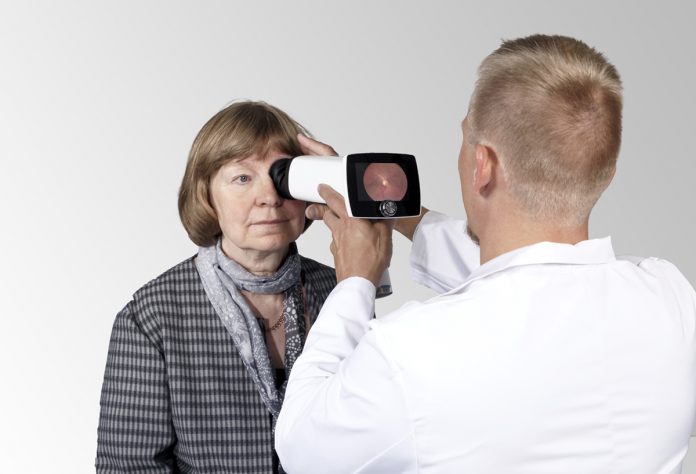Petri Huhtinen from Organisation Optomed OY Ltd argues that proper diabetic retinopathy (DR) monitoring improves health and saves money
The World Health Organization (WHO) has estimated that diabetic retinopathy (DR), which is an eye disease caused by diabetes mellitus, is responsible for 4.8% of global blindness (1). It affects up to 80% of those who have had diabetes for 20 years or more (2). At the same time, it has been estimated that at least 90% of new cases could be reduced with proper monitoring and treatment of the eyes (3).
Furthermore, several studies have shown, that proper and well-organised management of DR would also be cost-efficient (4). So, one can conclude that proper management of DR would both improve the health of the diabetic population and create savings on health expenditure. Still, a great majority of the world’s diabetic population do not receive the recommended eye examinations (5).
DR screening should be portable, non-mydriatic, reliable and easy-to-use
The relevance of proper DR management can also be assessed based on the Wilson and Jungner criteria for screening (6). The 10-step screening criteria evaluates disorder based on its importance as a health problem, the availability of screening and diagnostic test and treatment, and the economic effects; i.e. is it cost-saving to screen and diagnose proactively, instead of treating it based on visible symptoms?
To recap, screening should improve health and save costs. (6) DR is a school-book example of a condition that should be screened for, as it meets all the screening criteria. Therefore, it is inevitable that DR screening should be made available for all, to maximise health benefits and overall cost savings.
DR screening can and should be organised so, that it meets the local needs and regulations. It means that there is not one correct technology or infrastructural set-up for screening. With that said, Pasquel and colleagues concluded that the ideal screening technology should be portable, non-mydriatic, reliable and easy-to-use (4). Optomed has been designing and manufacturing mobile fundus cameras for more than ten years, and the latest fifth generation camera, Optomed Aurora®, meets all the camera-related specifications of ideal screening technology as listed by Pasquel’s group.
Optomed offers a holistic DR screening solution
In addition to cameras, Optomed also provides telemedicine and information management solutions for screening. This makes Optomed a one-stop-shop for DR screening programmes seeking for reliable clinical outcomes and optimised efficiency. Optomed Screen® is a screening management solution that automates the screening process completely. Once the data of the screening population is downloaded into the system, Optomed Screen® schedules screenings and sends out invitations. The screening data; i.e. the images; are stored in a server that can be accessed by specialists responsible for image analysis. The analysis could also be automated using artificial intelligence (AI)-based analysis tools. The third option for analysis is a combination of human grading and AI-analysis.
So, each screening programme can organise the analysis to serve best the programme set-up and match the resources available. Optomed Screen® also provides tools to monitor and optimise the efficiency of the programme. The programme coordinator can follow the statistics of each screening site, to find out if the population is being screened, and to assess the performance of individual screening centres. This feature can be very useful especially when allocating resources and assessing training needs. The solution is cyclic, meaning that new invitations are scheduled based on the findings and specialist comments. Thus, once screening population data is downloaded, the process really is automated.
It is widely acknowledged that DR should be screened for, and proper screening management would both improve the health of the diabetic population, and generate savings on overall health expenditure. However, it is regrettable that too low a proportion of the diabetic population is being screened regularly. One of the main reasons being poor accessibility of the screening centres. Optomed is doing its share to solve the accessibility issue by providing a solution consisting of a mobile non-mydriatic camera, and screening management system. The solution brings DR screening to people and at the same time generates efficiency through automated processes, telemedicine and even AI-based analysis.
References
1 World Health Organization. Vision impairment and blindness. Media centre, Fact Sheet, October 2017, www.who.int/mediacentre/factsheets
2 Kertes PJ, Johnson TM, eds. (2007). Evidence Based Eye Care. Philadelphia, PA: Lippincott Williams & Wilkins.
3 Tapp RJ; Shaw JE; Harper CA; de Courten MP, Balkau B, McCarty DJ, Taylor HR, Welbom TA, Zimmer PZ; AusDiab Study Group (2003) The prevalence of and factors associated with diabetic retinopathy in the Australian population. Diabetes Care. 26: 1731-1737.
4 Pasquel FJ, Hendrick AM, Ryan M, Cason E, Ali MK, Narayan KM (2015) Cost-effectiveness of Different Diabetic Retinopathy Screening Modalities. J Diabetes Sci Technol 10: 301-307.
5 Mukamel DB, Bresnick GH, Wang Q, Dickey CF (1999) Barriers to compliance with screening guidelines for diabetic retinopathy. Ophthalmic Epidemiol. 6: 61-72.
6 Wilson JMG and Jungner G (1968) Principles and Practice of Screening for Disease, World Health Organization.
Please note: There is a commercial profile
Petri Huhtinen, PhD
Business Unit Manager, Solutions Sales
Organisation Optomed OY Ltd
Tel: +358 40 526 5789











